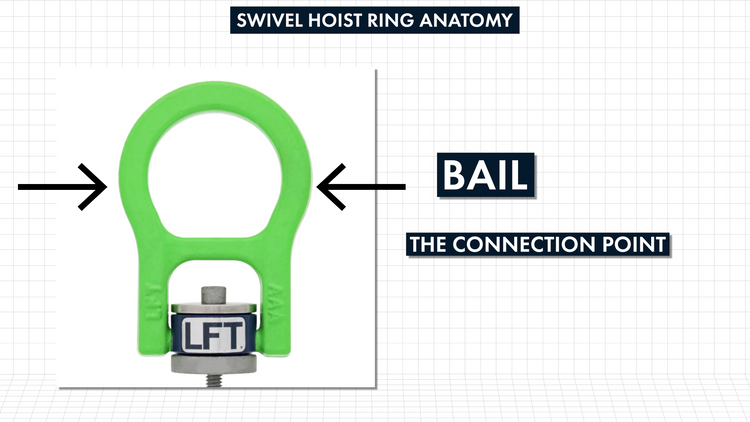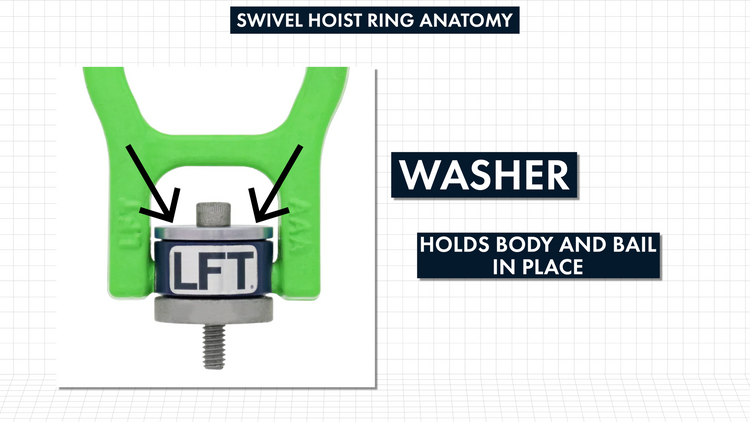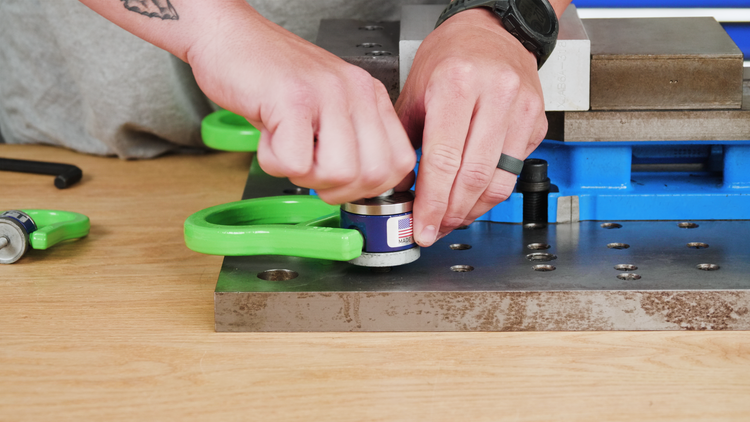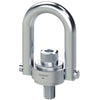Swivel Hoist Rings are a great option for lifting or moving machinery, workpieces, and other objects. Today, we’re going to explain the different working parts of a swivel hoist ring, how they work, and the benefits of using them over other lifting points. Be sure to stay till the end of the video for important safety tips.
Swivel Hoist Ring Anatomy
The swivel hoist ring is made up of several different load bearing parts that work in conjunction with one another to ensure reliable and successful lifts.
The first part we’ll talk about is what’s called the ‘bail’. The bail is drop forged for strength and serves as the connection point. Any lifting component that is attached to the bail must comfortably fit within the opening to prevent binding. The bail has protruding lugs that lock into the body for a secure pivoting connection.
The body swivels around the bushing and is held in place by the load bearing washer. There are slight clearances designed into the body that allow the body to swivel freely once the hoist ring is torqued.
The washer holds the body and bail in place once the bolt is torqued down. It also displays the product data such as a part number, serial number, rated load, and recommended torque specifications.
The bushing provides the needed compression to the surface of the object to allow the hoist ring to freely swivel without loosening the bolt during the lift. The bushing is designed to have a wide enough base to allow the hoist ring to hold 100% of the rated capacity for inline loads, and up to 90-degree angled loads.
The bolt provides enough holding strength when properly torqued, to allow the hoist ring to freely swivel without the bolt loosening during the lift. The thread engagement of the bolt must be at least 1.5x the bolt diameter. The torque values are marked on the hoist ring and are intended for clean dry threads.
How Swivel Hoist Rings Work
Swivel hoist rings serve as a versatile lifting point that provides multidirectional articulation, making them ideal for complex lifting tasks.
Since the bolt, bushing and washer provide tension and compression, they’re rated for 100% of the working load capacity at the full range of the hoist ring’s ability to pivot and swivel, if the swivel hoist ring is not in a bind.
It’s important to note that swivel hoist rings are not intended to swivel under load. Instead, the “swivel” part of the name refers to their ability to swivel and pivot while loading. This allows the swivel hoist ring to self-align, which provides an un-bound in-line load path for the rest of the rigging assembly.
Other Lift Points Versus Swivel Hoist Rings
While traditional lift points like machinery eyebolts are limited in their functionality due to their reduction in load capacity at different angles of attachment. Swivel hoist rings can be used for a wide variety of lifting applications and are not as restricted by angled loading.
Conventional hoist rings can be an option to increase the angle of attachment. However, they can only be operated on one plane of motion.

Unlike traditional hoist rings which hinge on one axis, swivel hoist rings provide multidirectional movement around different axis, making them ideal for complex lifting tasks like multi-leg lifting.
Additionally, swivel hoist rings offer a wider component connection compatibility, and can be used with safety hooks, chain slings with multiple legs, web slings, round slings, wire rope slings, soft rope, and more.
If you need a hoist ring that can turn and align to different angles and minimize stress on lifting assemblies, then swivel hoist rings are the perfect choice.
Swivel Hoist Safety
Correct installation of swivel hoist rings is vital, since improper installation and use can lead to lift failure and unsafe working conditions.
You’ll need to inspect all parts of each hoist ring for wear and tear on a regular basis. Also, the torque requirements for the bolt should be checked periodically as bolts could loosen in extended service.
When installing swivel hoist rings, always tighten the bolt to the manufacturers specified torque values. Following the torque guidelines puts proper tension on the bolt allowing your hoist ring to operate at its full listed working load capacity.
Never install a washer or spacer in between the bushing and the surface of your object. The bushing of the hoist ring should be in full contact with the surface of the item being lifted.
It’s very important to avoid putting your swivel hoist ring in a bind. Use spreader bars if necessary to prevent binding of the bail against the workpiece and ensure even load distribution.
For more information on swivel hoist rings, read our Hoist Ring Guide.

















